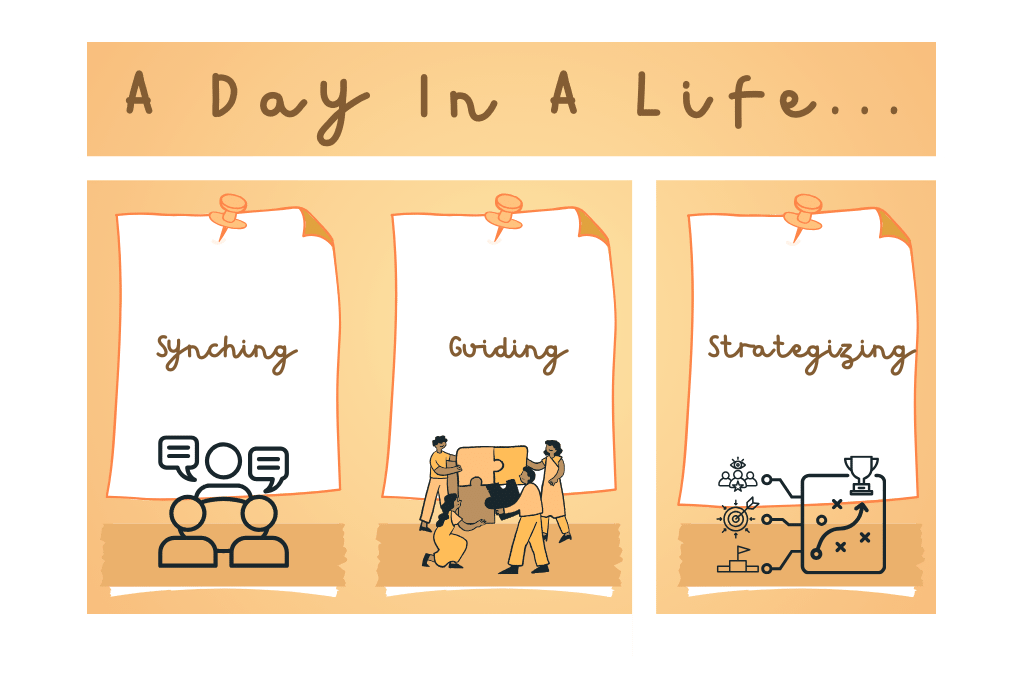TPM, Scrum Master, portfolio management. Although I’ve been living and breathing this world these past several years, it may all sound like jargon to you. I would have never imagined that I would be in the position that I’m in today. Why? Well, I was extremely shy in college and dreaded any class that revolved around participation points or Socratic discussion. I could go on, but that’s a tale for another day…
Instead, today, I’m going to bring you into my world and give you a taste of the day in the life of a technical program manager (TPM). Note that every company and even different departments within a single organization may have a different view of the roles and responsibilities of a TPM. However, I like to think that this role can be broken down into three parts.
- Synching
- Guiding
- Strategizing
Also, I don’t have a clear definition of a TPM. I’ll leave it up to you to summarize your findings based on what you read here and see across the various industries. This role has quite a bit of ambiguity. Those that do well excel at taking initiative, managing relationships, and organizing information. If you’d like to learn more, be sure to comment below!
Part I: Synching
My mornings are busier than most since I work with a global team. Therefore, I usually meet with my counterparts and delivery teams to understand where we are in achieving our commitments. If I prepare well, I will also meet with TPMs we have dependencies with to ensure we resolve any conflicts and align on any changes to the timeline.
Beyond the work itself, synching aims to grow technical expertise and strengthen relationships among my various team members. This could be done by reviewing a bug and understanding its root cause. Or, we could just take the first few minutes to be human and share anything that’s on our minds and take us away from our work. Since we have such a short time together, we must come together with a purpose.
Part II: Guiding
Hence, the bulk of my job revolves around guiding my leaders and teams. Guiding can take on many forms. I could facilitate a technical discussion between multiple, cross-functional teams on integrating our applications. On other days, I’m coaching our leadership teams and providing recommendations on improving employee engagement or our product. Then on other days, I’m representing our team and providing the pros and cons of our technical solution and why it’s the best path forward.
Each day is different. It all depends on the needs of my teams and our products. I have to listen closely and assess the verbal and non-verbal cues–which can be tricky in a hybrid and global environment–and decide what action to take. This means I could fall back and let my tech lead drive the discussions or step up and challenge our thinking.
Part III: (Reflecting and) Strategizing
Given that I started as a scrum master before entering program management, I have a stronger-than-usual relentless improvement mindset. After lunch, I review the notes from my morning engagements and take note of any relationships I need to improve, processes to simplify, or escalations. If I miss a meeting, I’m one of the few that goes back through a recording! Why? Often, I want to make sure I understand the decisions that were made especially if they revolve around architectural design.
After that, I spend the rest of the afternoon building plans that support the improvement of work execution and delivery. I also check in with various people to refine my recommendations, manage delivery expectations, or get feedback. It is a bit tricky because I work with folks in Europe. By the afternoon, they are well into their bedtime, so I try to provide offline updates and look for ways to improve communication.
At the end of the day, I usually take a step back and check in to see how my work aligns with my team’s overall goal. From there, I find 1-2 items to focus on the next day and then enjoy my evening.
In conclusion
In the end, this is one of the many different ways a TPM goes about his or her day. For me, it’s all about providing my technical expertise to ensure that my teams deliver value as effectively as possible. There are some days I lean more into the coaching, while on other days I’m working with stakeholders to determine the best path forward. The variety is what makes it challenging and interesting.
Curious to learn more? Be sure to check out our InBiteSize podcast or learn how we’re expanding our toolkit through books.
